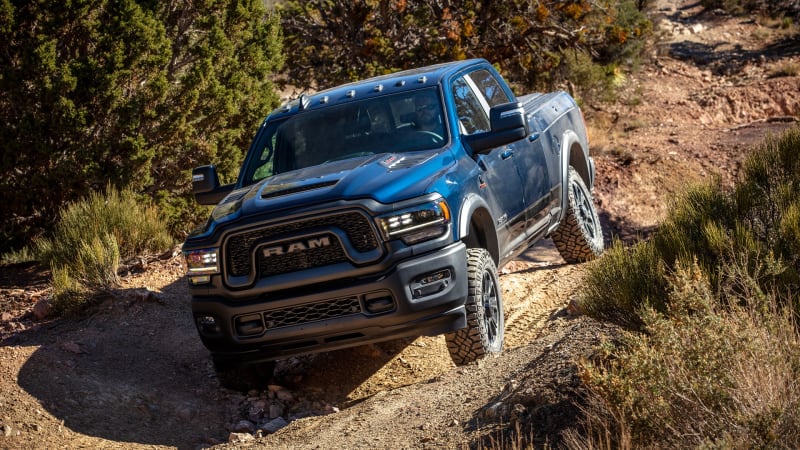PIONEERTOWN, Calif. — A vocal subset of Ram truck enthusiasts has long clamored for a particular combination: a Power Wagon with a Cummins turbodiesel. Well, they still aren’t getting one. But the 2023 Ram 2500 Rebel is meant to be the next-best thing, as it does indeed offer that long-coveted turbodiesel, while adding and subtracting in a few places to create something that’s more heavy-duty truck and less rock crawler.
First, what the Rebel shares with the Power Wagon. The only body choice is a Crew Cab and 6-foot-4 bed, with a choice of five- and six-passenger seating. Buyers can choose between the same BorgWarner part-time transfer case, with a choice of electronic or manual shift operation regardless of engine. It includes 4Hi and 4Lo (crawl ratio of 2.64:1), with the latter requiring you shift into Neutral. At the rear, the Rebel inherits the same electronic locker and electronic limited-slip differential. The 20-inch wheels are wrapped in 33-inch all-terrain rubber. The same skid plate package is shared, as is the same general look apart from a slightly different grille mesh and 20-inch wheel design. Basically, apart from the lack of POWER WAGON sticker on the bed side, it would be awfully tough to tell the two apart.
Standard on the Rebel is the Power Wagon’s only engine option: the 6.4-liter Hemi V8 good for 410 horsepower and 429 pound-feet of torque. A ZF-sourced eight-speed automatic is standard.
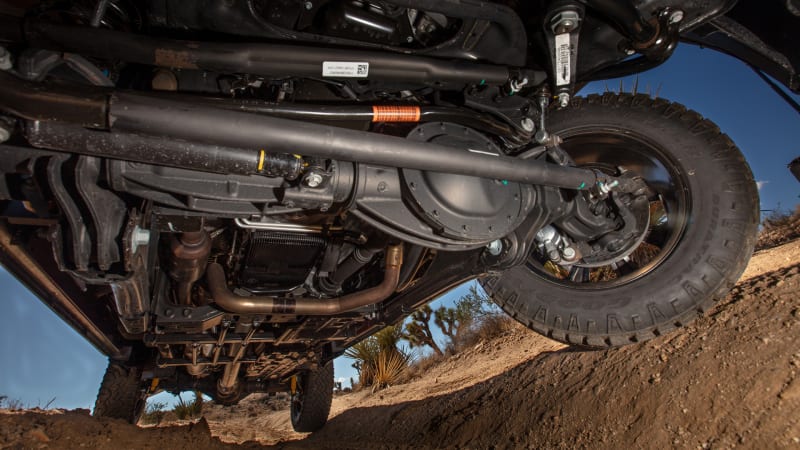
Now, what the Rebel does not get. Up front, there’s no electronic front locker, nor the disconnecting sway bar and extra rear suspension joint that allows for the Power Wagon’s absurd suspension articulation. To that same end, the Power Wagon has softer springs at the rear than other 2500 Rams, but the tradeoff for all that rock-crawling articulation is a considerably lower tow rating of 10,590 pounds and payload of 1,630 pounds.
The Rebel gets firmer rear springs, which zaps articulation, but allows for massively upgraded heavy-duty trucking. The tow rating jumps to 16,870 pounds with the 6.4-liter, while the payload goes up to 3,140 pounds. Towing goes down by about 2,000 pounds with the Cummins since the engine weighs so much more. What you gain, though, is nearly twice the torque. The 6.7-liter inline-six sends 370 hp and 850 lb-ft of torque through a six-speed automatic. Sorry, you can’t get the 1,075-lb-ft High Output version, but let’s not be choosers, beggars.
You also can’t get the 12,000-pound Warn Zeon-12 winch when you opt for the Cummins, since there’s basically not enough space up front for both winch and diesel to coexist. That’s a big reason the Power Wagon doesn’t offer the diesel. If you’re OK with the 6.4-liter, though, the winch can be added to the Rebel.
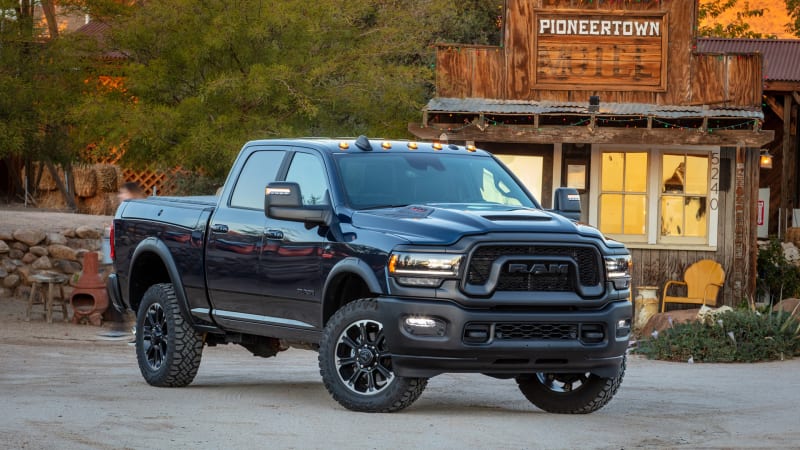
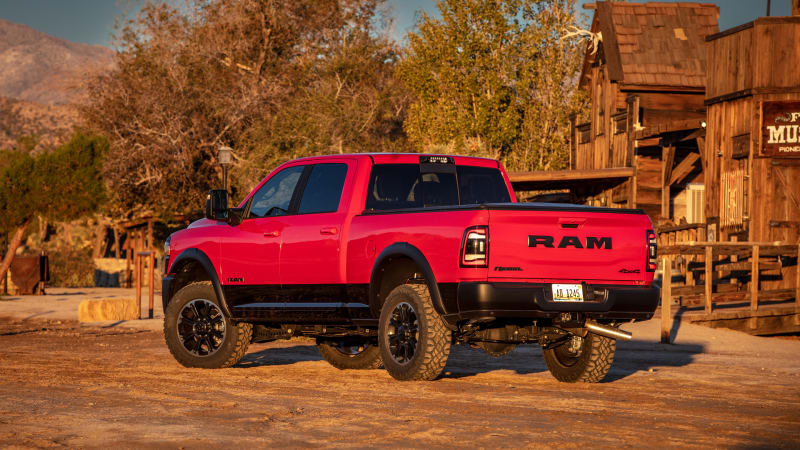
Out on the road, the Rebel feels every bit the heavy-duty truck with a big-honking diesel engine. Acceleration can at once feel lethargic, and then full-on angry stump puller. The six-speed automatic is innocuous enough under normal conditions, but climbing several thousand feet into the mountains toward Big Bear Lake, Calif., demonstrated a reluctance to downshift. It’s worth wondering whether you’d prefer the 6.4-liter and its extra two gears while towing despite the torque deficit.
The all-terrain tires add vagueness to the steering, but the hydraulic system thankfully still manages to provide just enough response to prevent any spooky moments while keeping the truck in a straight line. The Ram HD doesn’t have a telescoping steering column, though, so for those who sit a bit rearward, finding an ideal position may be difficult. Worse, your head might slam into the B pillar while off-roading, ask me how I know.
Although I didn’t get a chance to drive the Power Wagon and Rebel back-to-back, the hardware differences and past experience would lead me to believe that the Rebel won’t ride as comfortably on- or off-road. The firmer springs and lack of the disconnecting sway bar being the main culprits. This is definitely a firm-riding truck, and although it won’t beat you up (OK, so if you’re driving over a rock-strewn trail, it’s going to beat you up), there is a price to pay for opting for a heavier-duty truck. This definitely applies when comparing the 2500 Rebel to its 1500 Rebel sibling: You’re going to be a lot happier driving the 1500 on a daily basis even if you can’t tow a small house.
That said, the 2500 Rebel still has rear coil-over springs with the added option of air suspension versus the leaf springs found in Ford and GM’s heavy-duty pickups. This not only results in superior ride comfort, but improved handling and trailer control. Theoretically, the Rebel may not be as livable as a Power Wagon, but should be more pleasant than a Ford F-250 Tremor or GMC Sierra 2500 AT4. Theoretically at least.
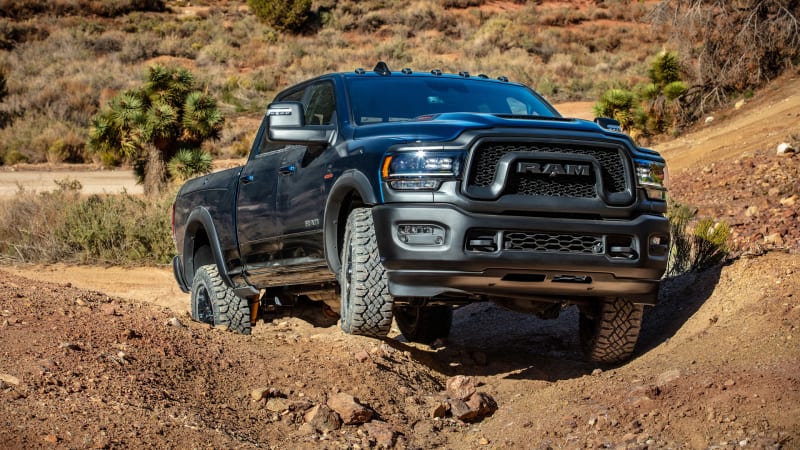
Off-road, the Rebel may be less capable than the Power Wagon, but that’s pretty much the highest bar you can try to clear in the off-roading truck realm. A rock-strewn trail with nasty ruts was dispensed without a second thought, confident that the truck’s ground clearance, articulation and giant all-terrain tires would shrug it all off. For a much greater challenge, several comically steep hill climbs with deep ruts were dispatched by simply holding the accelerator steady and allowing the 4Lo, rear locker and Goodyear Wranglers do their thing. Hill-descent control is included, but my right leg and the brake pedal work capably enough. If you’re looking for newfangled Selec-Terrain-style off-road modes, you won’t find them here. This is old-fashioned off-roading where the hardware and the driver take precedence over the computers.
Now, it’s not like the trails and off-road “playground” we tackled in the Rebel are likely anything special. A Wrangler driver would probably shrug and say “no big deal.” It’s that they can be tackled in a heavy-duty truck that could tow three of those Wranglers to that trail.
Should you try that, the Rebel offers the same array of trailering aids as other 2500s. Chief among these are various cameras, including a new rearview camera mirror that not only displays the usual view from the tailgate, but adds the option for a split side view (the cameras are added to the otherwise standard power-extending tow mirrors) that expands your blind-spot coverage. You can also plug in an accessory camera that mounts to the back of a trailer, or even inside the trailer, should you want to keep an eye on horses or alpacas or troublesome children you’ve relegated to the toy hauler (do not do this).
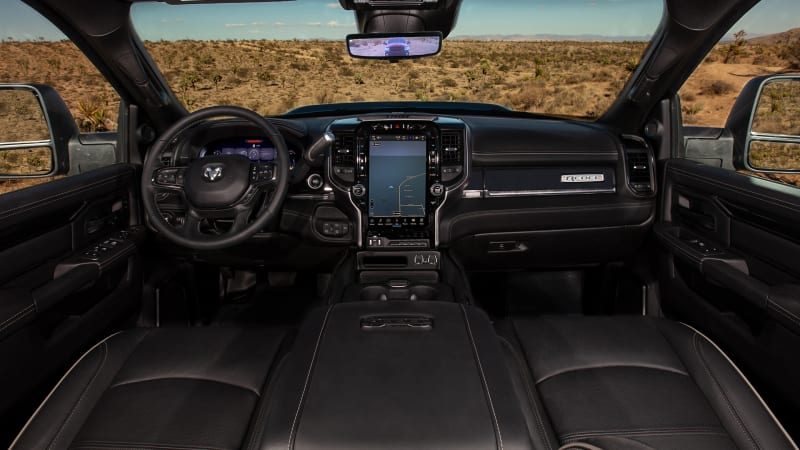
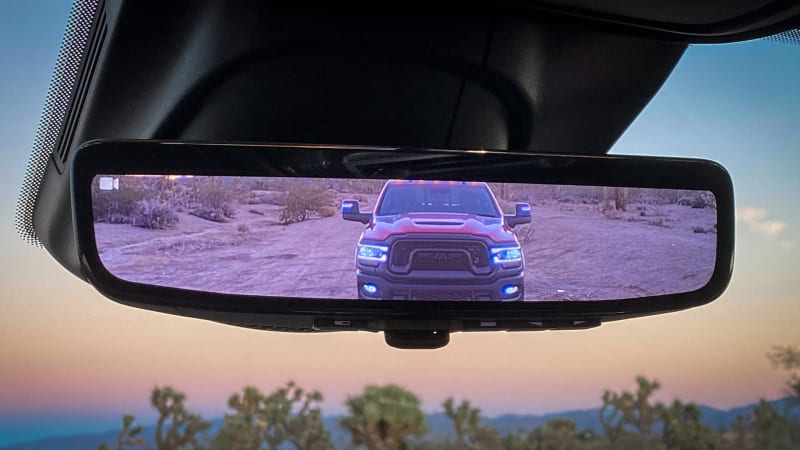
There’s also a forward camera, which may seem like a newfangled extra in this old-school off-roader, but this is also an enormous old-school off-roader with a hood that stands taller than many people. Seeing exactly what’s over that hill crest is harder than most, and without a spotter, good luck. With the camera, you always have that spotter. The forward view will stay active up to 12 mph and will return to it when you dip below 12 mph again.
Pricing starts at $68,940, including the hefty $1,895 destination charge. That’s barely less than the 2023 Power Wagon, which had its priced hiked up by $4,000 to $71,240 for ’23. It’s therefore best to think of the Rebel as a different type of off-roading Ram 2500 rather than a lesser version. Oh, and it gets a lot pricier. There are multiple options packages that replace cloth with leather, blank panels with cameras, and an empty grille with a winch (among various luxuries). Exact options pricing wasn’t available at the time of writing, but the big-ticket item, the Cummins, was a $9,595 option on the 2022 Ram 2500. So yeah, all that torque doesn’t come cheap: A diesel Rebel will be pushing $80,000 and probably will approach 90 large when loaded. That’s ultimately not that outrageous in the heavy-duty truck world especially when you consider you’re getting a pickup that can pull off extreme towing, hauling and off-roading.

